
Paul and Irina: Dark green text = edits by me (KWR) that are spot-insertions into your text. When I added whole paragraphs I felt it was obvious enough to leave in the normal black color.
The following is a greatly expanded version of Irina's
original article on the Kasparov-World Queen Endgame, kept at
SmartChess Online
Magazine (click on "Kasparov vs. the World---An Analysis"
halfway down the page). This new analysis
draws upon Peter Karrer's compilation of Exhaustively Generated Table-Bases
(EGTBs) that show perfect play for all positions after one of the
Black pawns has been captured. Karrer's files have been made available
on a public server maintained by the Huntsville Ala. Chess Club and the
sponsorship of the Hayes Family. Their homepage is at
chess.LiveOnTheNet.com
(or click on the button at the end of this preamble for
an alternate path),
with master index
here.
Many direct links to this server are in the text, and it is easy
to try your own positions by editing the
FEN part of the URL in your
browser's address window.
The analysis when both Black pawns are present, however,
is all human, especially as KWR owns only the freeware
MacChess 5.0.1
and has used it in only the few places it is mentioned.
Karrer's files were too huge to transfer over the Internet
and had to be burned onto many CDs and physically mailed
from Switzerland to Alabama--!--hence doing a perfect tabulation of the
whole ("7-piece") endgame is not on the immediate horizon.
Comments on the analysis (refutations?) and other editorial suggestions
are welcome by e-mail to Ken Regan
or e-mail to SmartChess Online.
These pages were prepared by Regan using
Claris/FileMaker HomePage 3.0 and modified to make links
open up a second browser window.
All diagrams have been taken from MacChess 5.0.1 using
ScreenCatcher 1.5.

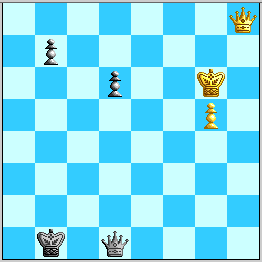
Diagram 1: Kasparov's vision from Move 38.
Garry Kasparov knew when he played 38. h6 in late August that he could force this position in late September. The analysis below, drawing on Peter Karrer's 6-piece EGTBs, confirms Kasparov's judgment that after 51. Qh7!, Black has little margin for error to avoid defeat. Had the endgame with 58...Qf5 been drawn, then this judgment would have been open to question, as it would mean that Black could play a silly blunder such as 51. Qh7 Kb2? and still draw after 52. Qxb7+. This is EGTB+/- with mate in 89 more moves, and optimal play after 52...Ka1 goes: 53. Qa7/a6+ Kb1 54. Qb6+ Ka1 55. Kh6 Qh1+ 56. Kg7 d5 57. Qd4+ Kb1 58. g6 Qh2 59. Kg8! Qb8+ 60. Kh7 Qh2+ 61. Kg7!! (a different Zugzwang from the main 58...Qf5 line but the same objective and tactics) Ka2 62. Kf6 Qd6+ 63. Kg5 Qe7+ and we even have the same move numbers as in 58Qf5.html! Likewise, 61...Kc2 62. Kf6 Qd6+ 63. Kg5 Qe7+ goes the same way. Thus the difference between losing and possibly holding is a single tempo. Moreover, two of Black's plausible replies to 51. Qh7 seem to lose.
Let's stop and make an assessment of the position at Move 51. In this endgame, Black has a material advantage, but White's advanced g-pawn gives him enough compensation for his pawn deficit. Note that without Black pawns on the board, this position would be a theoretical draw - and so we must keep it in mind that in many circumstances it will be quite acceptable and correct for Black to sacrifice his pawns to reach a theoretically drawn Q + P versus Q ending. This idea forms a key element in Black's defensive strategy.
In the game situation, White will seek to shelter his king from checks delivered by the Black queen, while trying to advance his g-pawn further towards the g8 promotion-square.
Also, in this endgame, Black has the important possibility of creating serious counterplay with the advance of his d-pawn and/or his b-pawn - the threat to advance the Black passed pawns can become the very catalyst required to make White eliminate Black's pawns while they are in transit, thus reducing the position to one that is theoretically drawn.
With the following analysis---human and fallible when two Black pawns are present, but by computer and perfect when one of them is taken---we claim to understand most of the play in this theoretically important family of endgames. The analysis supports many of the estimations and points of Regan's World Team Endgame Strategy article (written in mid-September before Move 50), most notably that Black must actively advance one or both pawns to draw, but it is important to note several points of divergence:
Cursory analysis of alternatives to 51. Qh7 shows that they do not seriously threaten Black. The only other try for White that seemed important at game time was 51. Qh5, which could be met by 51…Qd3+ or 51…Qc2+!?. For example, 51. Qh5 Qd3+, and now:
A) 52.Kh6 Qe3! and Black is OK.
B) 52.Kf6 Qc3+, and now:
B1) 53.Ke6 Qe5+ 54.Kd7Qb5+ 55.Kxd6 Qd3+ 56.Ke6 Qe4+, is equal.
B2) 53.Ke7 Qe5+ 54.Kd7 transposes to 53.Ke6 Qe5+ 54.Kd7 (Variation B2).
B3) 53.Kf7 Qc7+ 54.Ke6 Qc4+ 55.Kf6 Qf4+, with:
B3a) 56.Ke7 Qe5+ 57.Kd7 Qb5+ 58.Kc7 Qa5+ 59.Kxd6 (59.Kxb7 Qd5+ 60.Kc7 Qc5+ 61.Kd7 Qf5+ 62.Kxd6 is a theoretical draw) 59...Qd2+ 60.Ke5 Qe3+ 61.Kf6 Qf4+ 62.Ke6 Qe4+ 63.Kd7 Qd5+ 64.Kc8 Qc6+ 65.Kb8 Qd6+ 66.Kxb7 Qd5+, with a theoretical draw.
B3b) 56.Kg7 Qe5+ 57.Kh6 (57.Kh7 Qe7+, equal) 57...Qe3, transposes to Variation A.
C) 52.Kg7 b5 53.g6 b4, with equal chances.
Also, the much-discussed line with 51. Qh5 Qc2+!? 52. Kh6 Qc1 53. Qg6+ Ka2! 54. Qf7+ d5! 55. Qxd5+ is indeed drawn---note also that Ulf's fears about Qb6 blocking the b-pawn are well-founded in this case. Kasparov chose the best move:
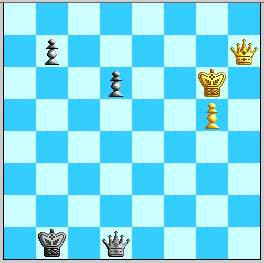
A very logical try to reorganize his remaining material so that the g-pawn can advance with effect. During September, we came to the conclusion that with 51…Ka1, Black could secure a draw with technically precise play. After 51.Qh7 Ka1! it is important to realize that Black does not fear the loss of his b-pawn. Thus:
A) 52.Qxb7 ( EGTB=; many moves draw but Black's next is most principled and looks easiest) d5 53.Kf7 (53.Kh6 Qd2! 54.Kg6 d4 55.Kf5 Qf2+ is equal) 53...d4 54.g6 d3 55.g7 Qf1+ 56.Ke8 Qe2+ 57.Kf8 d2, leads to a draw.
The most important variations follow the sequence:
B) 52.Qg7+ Ka2 53.Qf7+ d5
Now on 54. Qf2+, Black draws by pushing his d-pawn: 54...Kb1! 55. Kf6 d4 56. g6 d3 57. g7 Qg4. If White keeps the d-pawn pinned and plays 54. Kh7, Black plays 54...Qh1+! to force 55. Kg7 or 55. Kg8 and then pushes his b-pawn. The full analysis of 51...Ka1 is here.
Extensive analysis revealed 51…Ka1! to be a draw, and that we can consider 51…Ka1 to be (technically) the correct move for Black. I had, in fact, considered presenting the move 51…Ka1 with an accompanying draw offer by Black. I did not consider such a draw offer to be a breach of chess etiquette as I was convinced that not only did White not have any way of demonstrating any advantage against 51…Ka1, but also that after 50…d1=Q, the queen ending is just a draw. However, sentiment on the Bulletin Boards appeared to be against the WT offering a draw. The 51...Ka1 analysis was presented to the voting public---and except for 54...Qh1+! as an easier draw than 52. Qg7+ Ka2 53. Qf7+ d5 54. Kh7 Qc2+!?, our final version is unchanged. Remarkably (and without precedent), this move lost in the voting by a very narrow margin, to a move that had received less scrutiny and practically no supporting analysis from any MSN analyst. That move was…
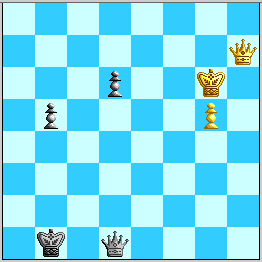
At first sight, this appears to be a reflex move to save the b-pawn from capture, as it was not so clear that the advance of the b-pawn at this time would create sufficient counterplay for Black.
Unfortunately, there was a much darker side to move 51 then anyone could have possibly imagined. A poster by the name of "Jose Unodos" claimed to have designed a method (which he described) for stuffing the ballot box with multiple votes for the move 51…b5. In the opinion of many, this turn of events caused the validity of the result of the vote at move 51 to be called into question (as the margin of victory for 51…b5 was quite small). The organizers quickly reacted by stating that no vote-stuffing had taken place, and their investigation indicated that such a practice was not possible. As we shall see, this statement will be contradicted by events occurring over the next few moves.
Regarding the issue of vote-stuffing at move 51 (or at any subsequent point in the game where it is believed to have taken place), I want to point out that I absolutely do not condone such activity - which is contrary to all sense of democracy, fair play and good sportsmanship. Nevertheless, the evidence that accrued over the following few moves regarding vote-stuffing allowed me to formulate a personal opinion that the validity of the result of the vote at move 51 (and therefore the validity of the game itself) is in serious doubt. Sadly, it appeared that my earlier predictions about "potential negative backlash and publicity" were going to come true.
From a chess point of view, the WT had to adapt to a suddenly altered game scenario - for the first time in three months a move suggestion by "Irina Krush" had been "ignored" - more accurately, a move suggestion by the vast majority of serious analysts had been ignored.
I tried to console myself with the idea that 51…b5 was as good as 51…Ka1 (in view of new findings in the 51…b5 52.Kf6+ Kc1 line), but realistically any move which makes a desired result more difficult (in this case a draw) is an error.
Kasparov's next is correct, because 52. Kf7+ would give Black 52...Ka1!? as a second drawing option. Then on 53. Qe4 the reply 53...b4! works because 54. Qxb4 Qd5+ (EGTB=) gives check and hits White's pawn. If White gives another check Black carefully sidesteps trouble via 53. Qh8+ Kb1! or 53. Qg7+ Ka2! Finally, 53. g6 fails to 53...Qd5+ because Black's 51...b5 opened up a8 and b7 as extra checking squares. Another virtue of White's next is freeing White's Queen for operations along the 7th rank if need be.
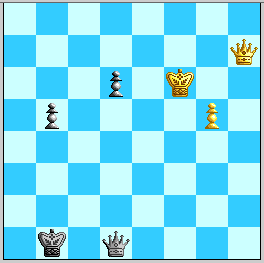
While it had been suspected that 52…Kc1 was the best response here (no useful checks for White, and Black does not block the path of the b-pawn) by some analysts I respected, both 52…Kb2 and 52…Ka1 were (correctly) undergoing examination. We now know that 52...Ka1? 53. Qa7+! Kb1 (allowing Qf2 with check loses even more quickly) 54. Qf2!, and now a killing Qf5+ awaits Black sooner with 54...Qd3/d5/g4 or later with 54...b4 55. g6 b3 56. g7. For 52…Kc1, there were a number of variations that needed deep human analysis to determine whether they were playable.
At this moment, a knight in shining armor who went by the name of "Alekhine via Ouija" (real name Carter Mobley), rode to the rescue and published line after line of deep and penetrating analysis (some of which he had formulated with other analysts, including Ross Amann) that demonstrated the efficacy of 52…Kc1. Other analysts joined in, and my friends at SmartChess Online managed to keep informed of developments (I was returning from Armenia where I had been playing in the World Women's U-20 Junior Championship). In a total of about 36 hours, the World Team had finally refurbished an old weapon to fight for a draw. A few important additions to the growing analysis tree took place during the WT voting period, when it had become clear that 52…Kc1 was Black's (technically) most correct move. Unfortunately, response time at the GM School web-site was slow on that day, and a recommendation for the inferior 52…Kb2 was maintained on their site even though it had been demonstrated that the one remaining line in 52…Kc1 that GM School did not like was in fact OK for Black.
The essence of the 52...Kc1! defense is the line 53. Qe4 b4! 54. g6 (54. Qxb4 Qf1/f3+ EGTB=, or 54. Qc4+ Qc2! 55. Qxb4 Qf2+! EGTB=) Qf1+ 55. Ke7 Qg1! 56. Qc4+ Kd1 57. Qd3+ Kc1 58. Kf7 Qf2+ 59. Ke8 Qe1+! 60. Kd7 Qg1! and Black holds. The full analysis, all known by the World Team on the evening of the crucial vote, is here.
So it appeared that 52…Kc1 held the draw. But alas it was not to be. A number of forces came together and provided the impetus for a move to win the vote (albeit only by a small margin) that would make Black's goal of achieving a draw even more difficult. It is here we can note an advantage for the World Champion - for not only does the World Team have to find a best move, it must also be able to generate the necessary momentum to vote for the best move! Two different problems that must be solved every two days!
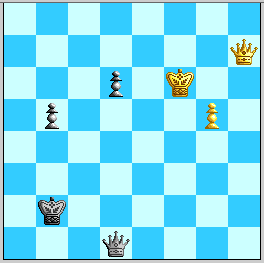
A decidedly second-best move. I was more surprised by this move than 51…b5 the move previously. Let's take a look at some of the factors that apparently contributed to the success of 52…Kb2 in the vote.
a) Two MSN analysts selected the move 52…Kb2 as their preferred choice, apparently (as best as I could tell from their commentary) with the idea of following up with Kb2-b3 to guard the Black pawns as they advance - (from a chess point of view, this strategy is probably suicidal and I think they made a chess misjudgment - fair enough, that happens in chess), while only one MSN analyst recommended 52…Kc1. The fourth MSN analyst was unavailable that day. So 52…Kc1 was outgunned 2-1 on the MSN Analysis Board.
b) GM School had still not updated their own web-site with the latest findings about 52…Kc1 (we were closing in on the weekend and they were possibly understaffed). GM School is not necessarily a decisive factor in the vote, but their reputation and (justified) popularity certainly motivates an important part of the vote. It is not beyond the realm of possibility that with the necessary update to their web-site, GM School could have been swayed to support 52…Kc1.
c) Moderator GM Danny King, who was usually neutral in his commentary, came down strongly against 52…Kc1, citing some weak (and irrelevant) analysis to support his "gut feeling" that 52…Kc1 was not correct. This was not only like having a third analyst aligned with 52…Kb2 (a move of which King approved), but a high-profile antagonist to 52…Kc1 was also established. I was very disappointed in Danny King's treatment of 52…Kc1, and I felt he played a major role in undermining the analysis of the WT on this move.
d) Finally, a few vociferous hold-outs on the Bulletin Boards were championing 52…Kb2 all day long on the basis of some weak 52…Kc1 computer analysis. I am not sure that this is an important factor, as I think relatively few votes can be garnered in this way for one move or another.
Not surprisingly, a combination of these factors led to 52…Kb2 being a winner in the polls. It was at least reassuring that the margin of victory for 52…Kb2 was quite low, for this indicated to me that there were a substantial number of voters for whom concrete and thoughtful human and human-guided computer analysis remained important.
After 52…Kb2, Black's position was more critical than before - and WT had to adjust to a new set of difficult problems. While 52...Kb2 may not be a bad move in of itself - it sets the scene for the forthcoming error by Black.
We will see that the move 52…Kb2 simply jeopardizes Black's ability to demonstrate equality. [Indeed, it is a losing move if White plays 53. Qh2+ Ka1 54. Qf2! or maybe even better 53. Qe4!] Out of curiosity, I (IK) ran the position after 52.Kf6+ (for the first time) on a number of well-known computer programs, and sure enough they tend to gravitate towards slightly favoring 52…Kb2. To my mind, the move 52…Kb2 is something of a "computer move" and demonstrates what can happen when one becomes a bit too reliant on chess playing programs to carry out analysis for you. I was very disappointed that we didn't get to play 52…Kc1 - I was worried that I had not made a strong enough case for the move and he defense it initiated, but as Paul Hodges pointed out in an e-mail to me, "We are a team, we will play some great moves as a team, and we may play some bad moves as a team. 52…Kb2 is our move now - it may not be the best but we go forward with it, and try and find the best move next time." Attached to the note was an updated, re-organized and re-prioritized 52…Kb2 analysis file. While I was in Armenia, it was Paul Hodges who ensured I stayed informed about the game and developments. Due to my tournament schedule and travel arrangements, it was his willingness to stay awake at all bizarre hours for days on end that actually even saw me get my move 51 and move 52 recommendations to MSN for posting in the first place. I know how disappointed he felt about what he thought was two critical drawing chances being lost, but Paul seemed more worried about the strength of the BBS being drained away by mounting concerns that the last two votes would leave the general voting public completely disassociated from the core of analysis activity on the Bulletin Boards. "I think the BBS needs to feel it will win a vote," Paul told me.
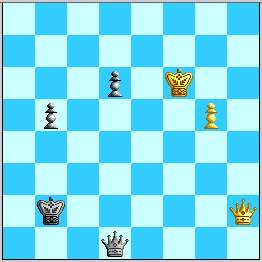
A free tempo to reorganize his forces! Black's ability to make a draw has been made much more difficult. Patient human analysis and advances in computer endgame tablebase technology will one day reveal to us whether Black's drawing chances exist at all after 52…Kb2 - for the moment, we believe that Black can just hold on with a precise sequence of moves and a calculated defense with absolutely no margin for error.
[That was written in November. As we've analyzed, we have found that the unexplored territory tends to favor White, and this is a case in point. During the game we believed that the centralizing 53. Qe4(!) could be effectively met by 53...Qf1+ and 54...Qc4! Indeed, we gave 53. Qe4 Qf1+ 54. Qf5 Qc4 55. g6 b4 56. g7 b3 as holding for Black, which it is. We also felt Black was fine with 53. Qe4 Qf1+ 54. Ke7 Qc4 55. Qg2+ Ka1/c1, as on 56. g6 Qc7+ 57. Ke6 Qc8+! or 57. Kf6 Qc3+, Black's checks will force White's King to the g-file at a time when Black is covering g7 and can play ...b4. However, the latest analysis (1/23/00!) reveals that the same idea of getting White's Queen to e1 from the 54. Qf2 Qd3 win works here: 56. Qg1+! Kb2 57. Qf2+ Ka1/c1 (57...Ka3 58. Qf3+ also gets White's Queen to a strong square with tempo) 58. Qe1+! Ka2/b2/c2 59. g6. Now with King on a2 or b2 Black can try 59...b4, but the intermezzo 60. Qf2+! crosses Black up, with the main line being 60...Ka3 61. g7 b3 62. Qf8! b2 63. Qa8+! and wins, or 62...Qe4+ 63. Kd7!, a deferred "Pin Battery"! Checking by 59...Qc7+ is no good after 60. Kf6!, when 60...Qd8+ is met by the strong interposition 61. Qe7! Notice how White's Queen on e1 is covering all the squares Black needs. And on 59...Qg4 60. Qe6! keeps the whips cracking, when 60...Qg3 61. Qf7!, 60...Qd4 61. Qf5+, 60...Qg5+ 61. Qf6 Qe3+ 62. Kf8!, and 60...Qh4+ 61. Kf8! all look bad for Black. I [KWR] expect that when the analysis being built here is completed, 53. Qe4 will be revealed as a quite snappy win!]
On this move, an inventive New Zealander demonstrated once and for all, that "vote-stuffing" was possible. Using the method described by "Jose Unodos" at move 51, he cast enough votes for the suicidal 53...Qe2 that it made the "Top 5 Moves" with a non-trivial percentage, a percentage greater than the margin by which 51...b5 overtook 51...Ka1. Thus he demonstrated that it was possible for Unodos' stuffing to alter the course of the game.
The best move available - although the Black king is surprisingly more vulnerable than we imagined on this square. If instead 53...Ka3/b3, White wins with 54. Qg3+ Ka4 (going back to the second rank allows 54. Qf2+ with tempo and loses quickly) 55. Qf4+! b4 56. g6. White's point in comparison with the analysis of 53...Ka1 54. Qf4? Qd5! is that Black must spend a tempo to cover g8, and after 56...Qd5 57. g7, Black cannot unpin with 57...Ka3 owing to 58. Qg3+. Likewise, 56...Ka3 57. g7 forces 57...Qa1+, but 58. Kf7 Qa2+ 59. Kf8 is over and out.
However, the remarkable report that the move 53…Qe2 (giving away the queen) had acquired nearly 5% of the vote could not be ignored. At first I had suspected that the organizers had made a typographical error and that this was meant to read 53…Qc2 (a plausible novice-like error). All was revealed when a regular contributor to the Bulletin Boards announced that he had used the "Unodos Method" for stuffing the move 53…Qe2 into the ballot box many, many times, and had therefore demonstrated that vote-stuffing was indeed a problem, and was indeed taking place, and was jeopardizing the integrity of the game.
All this set the tension in this endgame at a fever pitch for the crucial exchange of moves.
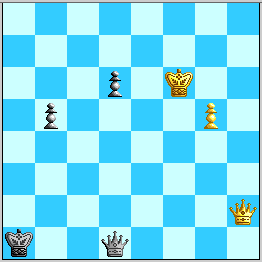
The World Team had now found itself having to quickly adapt to situations that it had not "wanted" for itself. With 54. Qf4, Kasparov completes a maneuver that activates and centralizes his queen, almost freely at Black's expense. But strangely, this centralization allows Black to defend by 54...Qd5!, as we show in our complete analysis of Move 54. Black also had to take into account the possibility of White playing 54. Qf2!? when it appears that Black has a promising defense with 54…Qd3. Analysis assisted by Karrer's EGTB tables shows, however, that 54. Qf2! is a winning move, with 54...Qd3 55. Qe1+! causing a crucial displacement of Black's King. Our Move 54 file covers this as well. Believing the situation after a Black Queen move to be desperate, we were led by analogy with the 52...Kc1 analysis to the following pawn sacrifice.
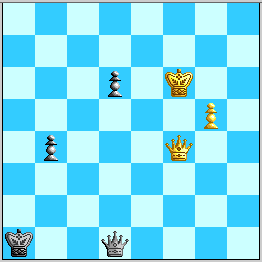
This pawn sacrifice idea is borrowed from the similar pawn sacrifice seen in the 52…Kc1 defense. White is practically forced to take the pawn. With the text, Black sacrifices the b-pawn in order to activate his queen and prepare the possible sacrifice of his d-pawn to reach a theoretical draw - however, it is now known that this pawn sacrifice 54...b4 is insufficient as the modified endgame tablebases designed by Peter Karrer show the position after 55.Qxb4 to be winning for White---it turns out that a1 is too vulnerable a square for Black king to enable the b5-b4 sacrifice to work.
My own analysis indicated that alternative defenses such as 54...Qd3 or 54...Qd5 were too passive to hold the balance, but these defenses will undergo even deeper scrutiny in post-game analysis to determine the crucial moment or "point of no return." If either 54...Qd3 or 54...Qd5 are shown to be sufficient for equality, then it will be revealed unequivocally that it was my recommendation (as played) of 54...b4 that lost the game for Black. If neither 54...Qd3 or 54...Qd5 are sufficient to hold the game, then we will have discovered that the move 52...Kb2 lost the game for Black.
An expanded discussion of the Move 54 mistakes, and our findings on 54...Qd3 and 54...Qd5, are here.
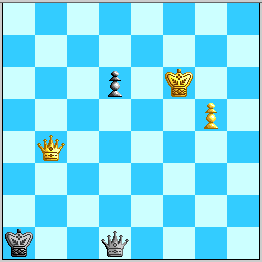
Declining the pawn allows Black a very easy game, for example: 55.g6 b3 56.Qa4+ (56.g7 b2! 57.g8=Q b1=Q 58.Qa8+ Qa2, leads to a draw) 56...Kb2 57.g7 (or 57.Qe4 Qc2! 58.Qd4+ Qc3 59.Qxc3+ Kxc3 60.g7 b2 61.g8=Q b1=Q 62.Qg3+, with a draw) 57...Qf3+, and now:
A) 58.Kg5 Qd5+ 59.Kf6 Qf3+ repeats.
B) 58.Kg6 Qd3+ 59.Kf6 Qf3+, with a draw.
C) 58.Ke7 Qe3+ 59.Kf7 Qf2+, and Black holds a draw as the pawn on g7 turns out to be weak!
The Peter Karrer endgame tablebases indicate the position after 55.Qxb4 to be winning for White---yet placing the Black king on c1 as in the 52...Kc1 defense indicates a draw, as originally postulated. The importance of this crucial difference was not appreciated at the time.
Insufficient is 55...Qd5 56.Qc3+ Ka2 57.g6 Qe4 58.Qa5+ Kb3 59.Qb5+ Ka3 60.g7 Qd4+ 61.Kf7 Qa7+ 62.Kf8 Qa8+ 63.Ke7 Qe4+ 64.Kd8 Qa8+ 65.Kc7 Qa7+ 66.Qb7 Qa5+ 67.Kc8 Qc5+ 68.Kb8 Qc4 69.Qa7+ Kb4 70.Qe7 Kb3 71.Qxd6, and White wins (as confirmed by the Peter Karrer endgame tablebases). Also insufficient is 55...d5 56. g6 Qf3+ 57. Kg5!
Black draws easily after 56.Ke6 Qh3+ 57.Kxd6 (or 57.Kd5 Qf5+, or 57.Kf7 Qf5+, equal) 57...Qg3+, with a draw, or 56.Ke7 Qe3+ 57.Kf6 Qf3+, repeating the position and compelling White to continue as in the game. [Indeed, the EGTB analysis shows this to be the only move to win.]
Black's alternative of 56...Qe3 also fails to hold the balance according to post-game analysis with Peter Karrer's endgame tablebases. I had investigated 56...Qe3 quite deeply, but had not come to a final conclusion about the continuation, while 56...d5 was widely considered at the time to be sufficient for Black to hold a draw. It appears at this time, we were laboring under the assumption or conclusion that Black was still able to (theoretically) hold a draw in this situation. Here are the important variations from 56...Qe3 mostly as we saw them at the time, although the ? marks for non-winning White moves are new.
A) 57.Qa4+ Kb2 58.g6 d5 59.Qb5+ transposes to Variation D4.
B) 57.g6? Qe5+ 58.Kh6 (58.Kh7 Qh5+ 59.Kg7 Qe5+ 60.Kf7 Qf5+ with a draw) 58...Qh8+ 59.Kg5 Qe5+ 60.Kg4 Qe6+, and Black is OK, because of the weakness of g6.
C) 57.Qxd6?? Qxg5+, is a trivial draw.
D) 57.Qa5+! Kb2, and now:
D1) 58.Qf5? d5 (not 58...Qe5+?? 59.Qf6, and White wins) 59.g6 (59.Qxd5 is a theoretical draw) 59...d4 60.Kf6 d3 61.g7 Qd4+ 62.Kg6 Qc4 63.Qf6+ Kc2, is equal.
D2) 58.Kf6? Qf4+ 59.Qf5 Qd4+ 60.Ke6 Qe3+ 61.Kxd6 with a theoretical draw.
D3) 58.Qd5? Qe5+ 59.Qxe5+ dxe5 60.Kf6 e4 61.g6 e3, draw.
D4) 58.g6? d5 59.Qb5+ (59.Qxd5 is a theoretical draw, while 59.Qb4+ Ka2 60.Kf7 Qf2+ 61.Kg8 d4 is equal) 59...Ka2, and now:
D41) 60.Qxd5+ is a theoretical draw.
D42) 60.Qa5+ Kb2 repeats.
D43) 60.Qf1 d4, with:
D431) 61.Kf8 d3 62.g7 Qc5+ 63.Kf7 Qd5+ 64.Kf8 Qd8+ (64...d2? loses to 65.g8=Q Qxg8+ 66.Kxg8) 65.Kf7 Qd5+ 66.Kf6 d2 67.Qd1 Kb2 68.g8=Q Qxg8 69.Qxd2+ draw.
D432) 61.Kf7 Qb3+ 62.Kf6 d3 63.g7 d2 64.Qe2 Qd5 65.Qg4 d1=Q 66.Qxd1 Qxd1 67.g8=Q+ draw.
D44) 60.Qa6+ Kb2, with:
D441) 61.Qf6+ d4 62.Kf7 Qb3+ 63.Ke7 (63.Qe6 Qxe6+ 64.Kxe6 d3 65.g7 d2 66.g8=Q d1=Q, draw) 63...Qb4+ 64.Ke6 Qb6+ 65.Kf5 Qxf6+ 66.Kxf6 d3 67.g7 d2 68.g8=Q d1=Q, draw.
D442) 61.Qf1 d4 62.Kf8 d3 63.g7 Qc5+ 64.Kf7 Qd5+ 65.Kf8 d2 66.g8=Q Qd8+ 67.Kg7 Qg5+ 68.Kh8 Qh5+ 69.Qh7 Qe8+ 70.Kg7 Qe7+ 71.Kg8 Qe8+ 72.Qf8 Qxf8+ 73.Kxf8 d1=Q, draw.
D443) 61.Kf7 d4 62.Qb7+ (62.g7 Qf4+ 63.Qf6 Qc7+ 64.Kg6 Qg3+ 65.Qg5 Qd6+ 66.Kh5 Qh2+ 67.Qh4 Qe5+ 68.Kh6 Qe6+ 69.Kh7 Qf5+ 70.Kh8 Qe5, with a draw) 62...Ka1 63.Qh1+ Kb2 64.Qg2+ Ka1 65.g7 Qb3+ 66.Kf6 (66.Kf8 Qb8+ 67.Kf7 Qc7+ 68.Kf6 Qd6+ 69.Kf5 Qd7+ 70.Ke5 Qe7+ 71.Kxd4, is a theoretical draw) 66...Qb6+ 67.Kf5 Qb5+ 68.Kg6 (68.Kg4 Qd7+ 69.Kf4 Qc7+ 70.Kf5 Qd7+ transposes to 66.Kf8) 68...Qe8+ 69.Kh6 Qe6+ 70.Qg6 (70.Kh7 Qf5+ 71.Kh6 Qe6+ repeats) 70...Qe3+ 71.Qg5 Qe6+ 72.Kh7 Qh3+, draw.
D5) 58.Qb5+! and now:
D51) 58...Ka1 59.g6 d5. Now we concentrated on 60.Qa6+ Kb1 61.Kf7 and felt that Black could defend (it is actually a win in 87 moves!). But what we overlooked here (and it's even better at Move 60) was 61.Qf1+! Ka2 (61...Kb2 loses to 62.Qf6+ Ka2 63.Kf8, while 61...Kc2 62.Qf5+ Qe4 63.Qf2+ transposes to the losing 56…d5 57.Qd4+ Kb1 58.g6 Qe4 line) 62.Qg2+ Ka3 63.Kh7! Qd3 64.Kh8 Qf5 65.Qg3+! Kb2 66.Qh2+ Ka1 67.g7 Qf6 68.Qh5, and White wins.
D52) 58...Ka3 59.g6 d5 60.Qa6+ Kb3 (60...Kb2 loses to 61.Kf7 Qf4+ 62.Qf6+) 61.Kf7! Qf4+ 62.Qf6 Qc7+ 63.Qe7 Qf4+ 64.Kg8 Kb2 65.g7, and White wins.
D53) 58...Kc2 59.Qc6+ Kb2 60.Qb7+ transposes to Variation D54.
D54) 58...Kc3 59.Qc6+ Kb2 60.Qb7+ Kc2 61.Qg2+ Kc3 62.g6 Qd4+ 63.Kf8 Qf4+ 64.Ke8 Qe5+ 65.Kd7 Qf5+ 66.Kd8 Qa5+ 67.Kc8 Qc5+ 68.Kb8 Qe5 69.Qb7 Kd2 70.Qb4+ Kd3 71.Kb7 Qe7+ 72.Kb6 Qd8+ 73.Ka7 Qf6 74.Qg4 Qg7+ 75.Kb8 d5 76.Qf5+ Kd2 77.Qxd5, and White wins as demonstrated by the Karrer tablebases.
Note that 56...Qf5 is also considered insufficient, when Black at best will eventually transpose into variations after 56...d5 57.Qd4+ Kb1 58.g6 Qf5, discovered to be losing in the post-game analysis.
Centralizing the queen, blockading Black's passed pawn, and exploiting the vulnerability of the Black king on a1 - it turns out that this is, in fact, the only winning move in this position for White (note that this resource is not available to White in the corresponding position in the 52...Kc1 defense, as Black's king is on the comfortable c1-square). During the game, we felt after the continuation….
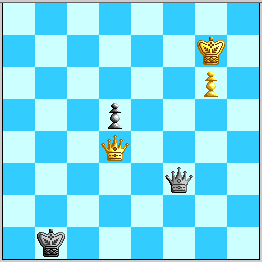
…that Black had very reasonable prospects for fighting for and achieving a draw. Certainly, Black's drawing chances would be much more difficult than after 51…Ka1, or 51…b5 52.Kf6+ Kc1, but the World Team was confident at the time that the continuation 58…Qf5 would lead to a draw.
What was known about this position with absolute certainty was that 58…Qe4 would not hold a draw.
The night before I had to make my recommendation for move 58, I had not received confirmation of Kasparov's move 58 by the normal time at either of my e-mail accounts (later we received the e-mails which were timestamped at normal times, and we made the obvious assumption that these e-mail transmissions had been hung up in an e-mail server). Soon I was going to bed - I was back at school and had tests starting early the next morning. I contacted Paul Hodges at SmartChess Online who told me he would wait up for the move, and that I should just get to sleep. Next morning, about 3 hours before the normal deadline for submitting a recommendation, Paul Hodges notified the organizers that my recommendation would be late and that I would send my recommendation as soon as I returned home from school that day. On my return from school that day, I was able to e-mail my recommendation to MSN - albeit after the normal deadline for submission of recommendations. Some time later I repeated the transmission of my recommendation, as neither Paul or I received any acknowledgement of my attempts to communicate with the organizers.
As I understand it, all during the voting period, the voters waited and waited, believing my recommendation would be posted "shortly". On many occasions, we had seen recommendations from other analysts posted at a later time (as was the case only two days later for Etienne Bacrot!). Within 10 minutes of receiving e-mail from me, SmartChess Online had my recommendation posted at its web-site. The idea that this series of events was "orchestrated" is ludicrous and unfair to people who have invested so much time and energy into making this project a success.
Here is the full text of my recommendation at move 58.
"I recommend the World plays the move 58…Qf5 (Queen on f3 to f5).
I believe that the active move 58…Qf5 is Black's best way to continue fighting for a draw. (Analysis has revealed severe problems with the alternative 58…Qe4 - and it looks bad for Black. I think 58…Qe4 is probably losing by force according to the latest analysis on the World Team Strategy Bulletin Board). Therefore 58…Qf5 to give us our best chances."
In a close vote, a move other than 58…Qf5 was chosen by the voters. Unfortunately, the move chosen (58…Qe4) had already been established by many analysts worldwide to be losing. Had my suggestion for the move 58…Qf5 been available for review (in addition to the proposal by Florin Felecan to play 58…Qf5), I believe the vote would have been in favor of the more stubborn 58…Qf5. However, as we now know, the position is still winning for White even after 58…Qf5, and so the events that transpired at move 58 turn out to be theoretically inconsequential.
The best move is the stubborn 58…Qf5 as originally indicated by GM Chess School. This endgame has been studied in detail by many analysts. However, one of the true WT experts on this endgame is IM Ken Regan, who has discovered many important ideas and variations that have allowed us to better understand this most difficult of endgame scenarios.
After 58…Qf5 play continues with 59.Kh6 Qe6 60.Qd3+ Kc1 61.Qc3+ Kb1 62.Qd4! (there are other methods to reach this position), returning to the same position after Black's move 59, except Black is now on move. This 'zugzwang' idea was first noted for the WT by IM Ken Regan.
First it can be demonstrated that 62…Kc2 fails as follows: 63.Kg5 Qe7+, and now:
A) 64.Qf6 Qe3+ 65.Kg4 - "The line that makes me sick," - Alexander Khalifman, after he had discovered this "problem" in the Black defense. At this time, I was studying this endgame in detail with the new FIDE World Champion, and we believed that this line spelled the end of 62…Kc2. Black continues with a sequence of only moves as follows: 65...Qg1+! 66.Kf5 d4! 67.g7 d3! when we believed the position after 68.Qc6+ Kd2! 69.Qg6 Qc5+! (all Black's moves are forced) 70.Ke4, to be winning for White. However, the Karrer tablebase (Peter Karrer) indicates that the previously not considered move 70...Kc1! is a draw!
However, White does in fact win with an important method not given much attention by either WT analysts or Kasparov and Alterman!
B) 64.Kh5! Qe8 65.Qf2+ Kb1 66.Qf5+ Ka2 67.Kg4 Qe3 68.Qf4 Qc3 69.Qf2+ Kb1 - we shall see this position again! - 70.Qf1+ Kb2 71.Kf5 Qc7 72.Qe2+ Kb1 73.Qd3+ Ka2 74.Qa6+ Kb2 75.Qe6 Ka2 76.Qf7 Qc2+ 77.Ke6! Qe2+ 78.Kxd5, and White wins.
On a side note, I would like to report that I was so pleased when Alexander emerged victorious from the grueling Las Vegas tournament to become the new FIDE World Champion - in a way this was so ironic for this modest player to achieve such a new height in his chess career. I remembered back to the time of his proposal of 18…f5! When we had exchanged some e-mails and analysis files. I had asked him how he would like the move credited when I made my report to the WT Analysis section, and Alexander provided me my favorite quote of the match when he told me, "18...f5! is a product of my own exhausted brain, but I still would like to ask you refer to GM School. MY NAME IS NO NAME." How wrong could he be?
So the World's fate hung in the balance of the move 62...Ka2. Largely through the efforts of IM Ken Regan, it was found that Black could hold many of the unclear positions that arise from 62…Ka2, and that the Kasparov-Alterman claim for a White win after 58…Qf5 based on their analysis (published shortly after the game was over) was not correct. However, the introduction of partial endgame tablebases to deal with this scenario (by Peter Karrer) indicated that White was indeed winning even after 62...Ka2.
After 62...Ka2 63.Kg5 Qe7+ 64.Qf6 Qe3+ 65.Qf4, a critical position is reached. Black's best defense in both the WT and the post-game Kasparov/Alterman analysis is 65…Qg1+.
For an in-depth treatment of the evolution and analysis of this defense, I highly recommend a visit to IM Regan's home pages on the Web dealing with this queen endgame. The analysis as it stood before the Karrer tablebases became available is at
while the recent analysis is here. The newly created Karrer endgame tablebase indicated the main line as:
66.Kf6 Qb6+ 67.Kf7 Qb7+, and now:
A) 68.Kg8 Qc8+ 69.Qf8 Qe6+ 70.Kg7? (Kasparov and Alterman called this "Position A" in their post-game analysis) 70...Qe5+ 71.Qf6 Qc7+ 72.Qf7 Qe5+! 73.Kg8 Qb8+ 74.Qf8 Qe5 (Kasparov and Alterman called this "Position G" in their post-game analysis). This variation is important because it is the line on which Kasparov and Alterman base their own winning for White argument - an argument which is in fact incorrect as 70.Kg7? actually ends White's winning chances (as shown originally by Regan and confirmed with the tablebases). With extensive analysis, Regan has shown that continuations other than 75.g7 do not hold any chance for advantage for White, and that White's only chance to obtain the initiative must follow 75.g7, allows Black to play 75…d4 after which Black holds a draw. Regan's seminal work in this area has been confirmed in its entirety by the new tablebases.
Instead of 68.Kg8, White can play the stronger:
B) 68.Ke6! and after 68…Qc8+ 69.Kf6 Qd8+ 70.Kf5 Qc8+ (or 70...Qd7+ 71.Kg5 Qe7+ 72.Kh6! Qe6 73.Qf3! and White wins) 71.Kg5 Qc3 72.Qh2+ Ka1 73.Qe2 Kb1 74.Qf2 Qc1+ 75.Kg4 Qc3 - a position we saw in the abortive 62...Kc2 defense, the winning method is now familiar - 76.Qf1+ Kb2 77.Kf5 Qc7 78.Qe2+ Kb1 79.Qd3+ Ka2 80.Qa6+ Kb2 81.Qe6 Ka2 82.Qf7 Qc2+ 83.Ke6 Qe2+ 84.Kxd5, and White wins.
So therefore it appears White is winning after 58…Qf5. This complex endgame was so difficult that even the World Champion's post-game analysis was found to be not sufficient to support his own claim that White held a winning advantage after 58...Qf5, an opinion that Kasparov boldly proclaimed before the actual game was even over!

59. Qg1+
White is winning in all lines. For this move, I posted my final analysis - essentially a compendium of the lines worked out by many WT analysts showing how 58…Qe4 loses. I would not post any further move recommendations, for the following reason: I knew the position to be lost, and considered it insulting to both Kasparov and my teammates to continue offering recommendations.
59. … Kb2
Although this is the best move (in a lost position), it was not the move that won the vote!
Annoyed by the fact that the organizers had not posted my suggestion at move 58 as had been indicated on the web-site, and that no mechanism for voting to resign had been provided for the voters, voters voiced their displeasure en masse and the "suicidal" move 59…Qe1 won the vote by a huge margin. In response, the organizers discounted the move 59…Qe1 (including all legal votes!), and installed the move 59…Kb2 as the duly elected move, citing "vote-stuffing" as the source of the incredible 59…Qe1. This controversial step was taken by the organizers despite their previous statements and assurances that "vote-stuffing" was either not taking place, or could not take place.
60. Qf2+ Kc1?
A weak move in a lost position. Maximum "resistance" is achieved with 60…Ka1, which indeed allows us to witness some pretty themes.
60...Ka1 61.Kf6 d4 (61...Qh1 62.g7 Qh6+ 63.Kf7 Qh5+ 64.Kf8, and 61...Qb4 62.g7 Qd6+ 63.Kf7 Qd7+ 64.Kg6 Qe8+ 65.Qf7, are winning for White) 62.g7 Qc6+ 63.Kg5, and now:
A) 63...Qc5+ 64.Qf5 Qe7+ (64...Qc1+ 65.Kf6 Qc6+ 66.Qe6, transposes to 63...Qd5+ 64.Qf5 Qg2+ 65.Kf6 Qc6+ 66.Qe6) 65.Kh6 Qd6+ 66.Qg6 Qf4+ 67.Qg5 Qd6+ 68.Kh7 Qh2+ 69.Qh6 Qc2+ 70.Kh8, White wins.
B) 63...Qc1+ 64.Qf4 Qc5+ 65.Qf5, transposes to 63...Qc5+ 64.Qf5.
C) 63...Qd5+ 64.Qf5 Qg2+ 65.Kf6! Qc6+ 66.Qe6 Qf3+ 67.Ke7 Qb7+ 68.Qd7 Qe4+ 69.Kd6 Qf4+ (69...Qg6+ 70.Kc7 Qg3+ 71.Kc8 Qc3+ 72.Qc7 Qh3+ 73.Kd8 Qh4+ 74.Qe7 Qg3 75.Qa7+ Kb1 76.Qxd4, and White wins) 70.Kc5, and now:
C1) 70...Qc1+ 71.Kb6 Qb1+ 72.Kc7! Qc1+ 73.Qc6 Qf4+ 74.Kb6 Qb8+ 75.Ka6 Qg8 76.Qa4+ Kb1 77.Qxd4, and White wins.
The following is perhaps my favorite variation of the game from an aesthetic viewpoint, for it shows how chess can be beautiful and unforgiving at the same time:
C2) 70...Qe5+ 71.Kb6 Qb8+ 72.Ka5 Qa8+ 73.Kb4 Qb8+ 74.Kc4 Qg8+ 75.Kc5 (not 75.Kxd4? Qa2!! and Black makes a draw) 75...d3 (75...Kb1 loses to 76.Kxd4) 76.Qd4+ Ka2 (76...Kb1 77.Qxd3+, and White wins) 77.Qc4+ Qxc4+ 78.Kxc4 d2 79.g8=Q d1=Q 80.Kc3+, with discovered check, and mate in a few moves! (as found by "Agent Scully").
61. Kf6
This is why 58…Qf5 was necessary - to prevent this maneuver with Kg7-f6 and g6-g7.
61. … d4
62. g7
The hopeless nature of Black's position had made itself apparent to even the most die-hard members of the World Team after the arrival of the White g-pawn on the seventh rank.
Black Resigned (1-0)
After 62…Qc6+ 63.Kg5 Qd5+ (63...Qe8 loses to 64.Qxd4, and after 63...Qc5+ 64.Qf5 Qe7+ 65.Qf6, White wins) 64.Qf5 Qg2+ 65.Kh6 (65.Kf6 Qc6+ 66.Qe6 Qf3+ 67.Ke7 Qb7+ 68.Qd7 Qe4+ 69.Kd8, wins for White; 65.Qg4 Qd5+ 66.Kh4 Qg8 67.Qf4+ Kc2 68.Qf8 Qh7+ 69.Kg5, winning for White) 65...Qh1+ 66.Qh5 Qc6+ 67.Kh7 Qe4+ 68.Kh8, White wins, and so the WT voters finally decided to call it a day.
I would like to thank, in particular, two people who worked behind the scenes throughout the course of the event to maximize the efforts of the World Team and to maximize my own ability to participate in this event - Paul Hodges and David Koval of SmartChess Online.
(This article is dedicated to my WT teammates all around the world. I thank my friends at SmartChess Online for their assistance in assembling and editing this article from material in my diaries, e-mail logs, and databases.)
To: Kenneth Regan <regan@cse.Buffalo.EDU>, Guy.Haworth@icl.com, jat@LiveOnTheNet.COM CC: Irina Krush <krush@smartchess.com>, hodges@smartchess.com
Subject: 54...b4 loses.
Or so my tablebases say. "Optimal" loss after 55.Qxb4 is our well-known 55. Qf3+ 56. Kg7 d5 (or 56...Qf5 which transposes) 57. Qd4+ Kb1 58. g6 Qf5. The (g7..g5, d6) tables have now been uploaded to John's server.
For 56...Qe3 Crafty gives this mainline:
1. Qa5+ Kb2' 2. Qb5+' Kc3' 3. Qc6+' Kb2' 4. Qb7+' Kc2' 5. Qg2+' Kc3' 6. g6' Qd4+' 7. Kf8 Qf4+' 8. Ke8 Qe5+' 9. Kd7' Qf5+' 10. Kd8 Qa5+' 11. Kc8' Qc5+ 12. Kb8' Qe5' 13. Qb7' Kd2' 14. Qb4+' Kd3' 15. Kb7' Qe7+ 16. Kb6' Qd8+' 17. Ka7' Qf6' 18. Qg4' Qg7+' 19. Kb8' d5' 20. Qf5+ Kd2' 21. Qxd5+' Ke1 22. Qe6+' Kd1' 23. Kc8' Qc3+' 24. Kd8 Qa5+' 25. Ke7' Qc3' 26. Qg4+' Kc1' 27. g7" Qe5+' 28. Kf7' Qc7+' 29. Kf6' Qd8+' 30. Ke5' Qc7+ 31. Ke4' Qc4+' 32. Kf3' Qf1+' 33. Ke3' Qe1+' 34. Kf4' Qd2+ 35. Kg3' Qc3+' 36. Kh2' Qd2+' 37. Kg1' Qe1+' 38. Kg2' Qd2+' 39. Kf1' Qd3+' 40. Kf2' Qd2+' 41. Qe2' Qf4+' 42. Qf3" Qh4+' 43. Kg2' Qg5+' 44. Qg3" Qd5+' 45. Kf2' Qf5+' 46. Qf3" Qc2+' 47. Ke1' Qd2+' 48. Kf1" Qd8' 49. Qc6+ Kb2' 50. Qg2+' Ka1' 51. g8=Q' Qd1+' 52. Kf2" Qd4+' 53. Kf3 Qd3+' 54. Kf4' Qd4+ 55. Qe4 Qf2+' 56. Qf3 Qh2+ 57. Qgg3 Qd2+ 58. Ke5' Qa5+' 59. Qd5' Qc7+' 60. Qd6" Qxd6+' 61. Kxd6" Kb1 62. Qh2 Ka1 63. Ke5 Kb1' 64. Kd4' Ka1 65. Kc3' Kb1' 66. Qb2#'
From regan@cse.Buffalo.EDU Thu Nov 25 12:47 EST 1999
To: Guy.Haworth@icl.com, hodges@smartchess.com, regan@cse.Buffalo.EDU
Subject: More on 62...Kc2---basically *unique* win!--? Cc: jat@LiveOnTheNet.COM, krush@smartchess.com, pkarrer@active.ch, regan@cse.Buffalo.EDU
I haven't had time to work out all the transpositions here yet, but I believe White has *only one* way to beat 62...Kc2. After
58...Qf5 59. Kh6 Qe6 60. Qg1+ Kb2 61. Qf2+ Kb1 62. Qd4 Kc2 63. Kg5 Qe7+,
the move 64. Qf6 is itself an error, and IM2429's 64. Kh5 is the only way to win. Then 64...Qe8 65. Qf2+! (which IM2429 gave) Kb1 66. Qf5+ Ka2 67. Kg4! Qe3! 68. Qf4! Qc3 69. Kg5! transposes into Fritz---Black's having the move here makes no difference. And on other Black Move-64's, IM2429's analysis at
http://www.gamersx.com/messages/view.asp?id=wnwcg
seems to be spot-on. In any event, 62...Kc2 seems by far the best practical chance.
From regan@cse.Buffalo.EDU Sun Dec 5 01:38 EST 1999
To: Guy.Haworth@icl.com, hodges@smartchess.com, jat@LiveOnTheNet.COM, krush@smartchess.com, pkarrer@active.ch, regan@cse.Buffalo.EDU, spy49@usa.net
Subject: Does "Heffalump" = Crafty?...
Dear All,
Here's an experiment I've meant to ask you before, regarding:
And I still agree on practical terms---take me as strong enough in this element to demur on "figure a 2800+ player will find the win" and contend that since after 58...Qf5 59. Kh6 Qe6 60. Qg1+ Kb2 61. Qf2+ Kb1 62. Qd4 Kc2 63. Kg5 Qe7+, the completely natural 64. Qf6?! is already a big step into quicksand (and it catches with 64...Qe3+ 65. Kg4?? but isn't perceived until the astounding---but something e.g. Ross Amann would have found---surprise 70...Kc1 *six* moves later), that trap would have caught any Heffalump on earth! By comparison, in this IM2429 line after 57...Qb8+ 58. Kg7 b4, I think that a 2600-player could be caught at least over-the-board in playing 59. Kh7(?) expecting ...Qa7+ 60. g7 b3 61. Kh8 b2 62. Qf6 "1-0" the way it caught me, and a 2700-player seeing that might still play 59. Kh7 in this format expecting to win with 60. Qf7.
Can someone with the most souped-up fast Crafty build see whether Crafty (*without Karrer's EGTBs but with KQQKQQ and the 5-piecers loaded) sees 70...Kc1 even at that move? My MacChess run for 4 billion nodes saw "+638" all the way, looking out 22 ply. I conjecture that even a similarly- equipped Deep Blue might not see it.
Also clearly none of the above will see that 59. Qd4+ is winning (if I am right)---I wonder if the evals from 59. Kh7 are higher.
Sincerely, --Ken
From pkarrer@active.ch Mon Dec 6 20:11 EST 1999
To: Kenneth Regan <regan@cse.Buffalo.EDU> CC: Guy.Haworth@icl.com, hodges@smartchess.com, jat@LiveOnTheNet.COM, krush@smartchess.com, spy49@usa.net
Subject: Re: Does "Heffalump" = Crafty?...
Hi Ken,
As expected, Crafty has no clue. Given the position after 58...Qf5 59.Kh6 Qe6 60.Qg1+ Ka2 61.Qf2+ Kb1 62.Qd4 Kc2 63.Kg5 Qe7+ 64.Qf6 Qe3+ 65.Kg4? Qg1+ 66.Kf5 d4 67.g7 d3 68.Qc6+ Kd2 69.Qg6 Qc5+ 70.Ke4 (before the drawing 70...Kc1!!) it first looks at 70...Qe3+, finds a problem after 50 seconds, then thinks for 22 minutes(!) before coming up with 70...Qc4+, then after 50 minutes it finds a problem with that. I stopped there but I guess it would take days if not weeks before even considering 70...Kc1.
Given 70...Kc1, the main line after 80 minutes (that's about 2.5 billion nodes) is
71.g8=Q d2 72.Qh6 Qb4+ 73.Kf5 Qc5+ 74.Kf6 Qc3+ 75.Kf7 Qc4+ 76.Kf8 Qb4+ 77. Kg7 Qb2+ 78.Kh7 Qb1+ 79.Qgg6 Qb7+ 80.Kh8 Qb2+ 81.Kg8 Qb8+ 82.Kf7 Qb7+ 83.Kf8 Qf3+ 84.Ke7 Qb7+ 85.Kd8 Qa8+ 86.Kd7 Qa7+ 87.Ke6 Qa6+ 88.Kf7 Qxg6+ 89.Kxg6
with an eval of +5.60. A series of checks like that is suspicious, so I think it is possible that an attentive Crafty operator would have taken a closer look at the position. If he had ever arrived at 70...Kc1, that is.
Regards, Peter
From regan@cse.Buffalo.EDU Tue Dec 7 13:27 EST 1999
To: pkarrer@active.ch, regan@cse.Buffalo.EDU
Subject: The amazing draw and some *long* wins...
Cc: Guy.Haworth@icl.com, hodges@smartchess.com, jat@LiveOnTheNet.COM, krush@smartchess.com, regan@cse.Buffalo.EDU, spy49@usa.net Content-Type: text Content-Length: 2164
Dear Peter and All:
>...Crafty's main line from 70...Kc1 is: > >71.g8=Q d2 72.Qh6 Qb4+ 73.Kf5 Qc5+ 74.Kf6 Qc3+ 75.Kf7 Qc4+ 76.Kf8 Qb4+ >77. Kg7 Qb2+ 78.Kh7 Qb1+ 79.Qgg6 Qb7+ 80.Kh8 Qb2+ 81.Kg8 Qb8+ 82.Kf7 >Qb7+ 83.Kf8 Qf3+ 84.Ke7 Qb7+ 85.Kd8 Qa8+ 86.Kd7 Qa7+ 87.Ke6 Qa6+ 88.Kf7 >Qxg6+ 89.Kxg6
It is highly interesting that this involves Qh6 not Qg5---this means that *both* moves are highly nontrivial. I still have not analyzed this, may do so during a meeting with Capablanca's nephew attending this afternoon.
I like to think that with the WT having found similar cases of K+P+Q holding out (or almost...) against KQQ (IM2429, Ross Amann, Paul...), we'd have found this one...
Now here is a *nifty* case of a position with one winning move, that wins in 95! White: Kg6, Pg7, Qf2; Black Kc1, Qc4, Pb4; White to move:
chess.liveonthenet.com/scripts/dbexplore?fen=8/6P1/6K1/8/1pq5/8/5Q2/2k5+w
Cheers (and thanks for the Crafty run) --Ken
Solution:
94. Qf7 Qc2/d3/e4+ 93. Qf5 Qc4 92. Kh6 Qg8 91. Qf8 Qe6+ 90. Kg5 Qd5+ 89. Qf5 Qd8+ 88. Kg6 Qd6+ 87. Kh5 Qh2+ 86. Kg5 Qg2+ (Qg3+ L78) 85. Qg4 Qd5+ 84. Kf6 Qd6+ 83. Qe6 Qf4+ 82. Kg6 Qg3+ 81. Kh7 Qc7 80. Kh6 [Qe1+ Kc2 79. Qe4+ (Qxb4 drawn) Kc1 78. Kh6 (Qxb4 drawn) is one move less efficient, I don't know why] Qf4+ 79. Kh5 Qf3/h2+ 78. Kg5 Qg3+ 77. Qg4 Qe5+ 76. Kh6 Qd6+ 75. Qg6 Qh2+ 74. Qh5 (Kg5=) Qd6+ 73. Kh7 Qd3+ (...Qc7/d7 L69; Qe7 L27) 72. Qg6 Qd7 71. Kh6'''! Qh3+ 70. Qh5 Qe6+ 69. Kh7''' Qd7 68. Qe5! (necessary? Kh8!? = W78) Kc2 (b3=L25) 67. Kg6 Qg4+ (or ...Qc6+ Kf5) 66. Kf7 Qc4/d7/f3+ 65. Kf6 Qc6+ (Kb1=L58) 64. Ke7 (do all alternatives transpose?) Qg2 (next is Qb7+ L32) 63. Qd4 Kb3 (next is Qg5+ L33) 62. Kf7 (2 moves better than Kf8, other moves actually drawn!! I guess Qe3/d3+ would drive Black to a4) Qf3+ 61. Kg6 Qg2+ 60. Kh5 (this must be how WK crosses the frontier) Ka3 (Qh3+ L52, note how Ka4 was verboten) 59. Qg4 Qh1+ 58. Kg5''' Qd5+/Qa8 57. Kh4 (also Qe6 if Black played Qa8, on Qd5+ it's Kh4''') Qg8 (Qd8+ L49) 56. Qf3+''' and now clearly it has flowed into John's line!